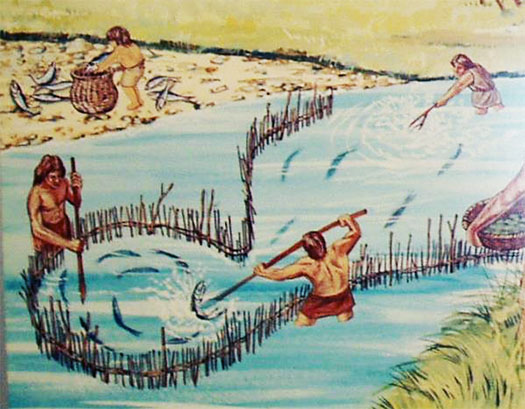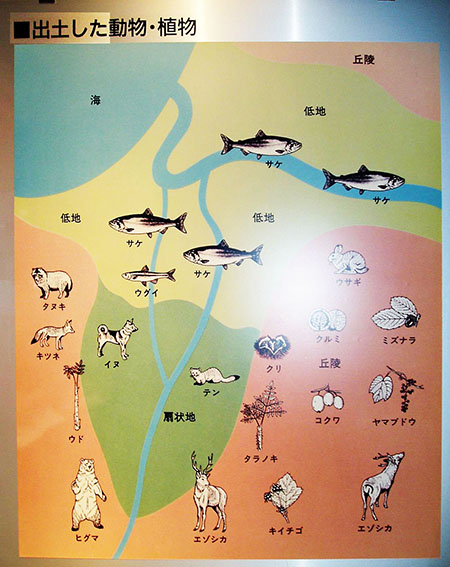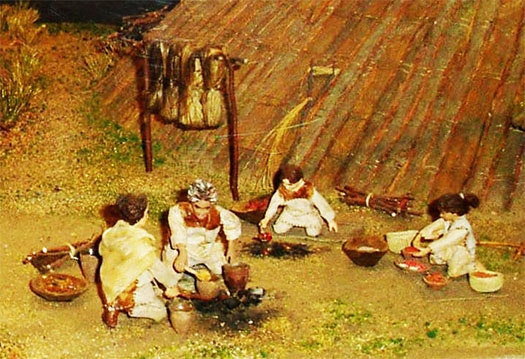
さてわが家から約4.5kmの距離、歩いても1時間、クルマなら10分かからない距離の遺跡。まことに「灯台もと暗し」で、日本全国あちこちと歩きまわっているわが身の愚かさに驚かされる(笑)。なんですが、まぁこれも人生であります。思い立ったが吉日と考えてよい方向で捉え直してみたい。気候風土的な同一性は担保された環境という想像力メリットのなかで、当時の経済行為・生業についてのことから考え始めてみたい。
北海道のこの当時西暦で600年代後半から1100年代は擦文文化期。


遺跡からは川底地形から杭が多数発見されたということで、具体的に「サケ漁」の様子が視覚化されていた。石狩川の支流の琴似川に沿ってこの遺跡は成立している。この時代のひとたちの生業判断として豊かに上ってくる秋サケ漁、その捕獲のしやすさ、漁の豊かさということは巨大な適地判断だったのだろう。イラスト図では腰高程度の水深の河川状況が推定される。川幅とか考えて見ても、この地域は最適環境だったに違いない。
その主要な生産財としてサケの干物加工品が大量捕獲されたと考えられる。それによって基本生業が確保され、そのほかの生活必要物資についても上図では発見された痕跡から多数の動物性タンパク源や、植物性の栄養素が確認されている。多数の植物栄養源については明日以降、触れてみたいが、実に豊かな食生活の痕跡が立ち上ってきている。

琴似川に面してのこの地域一帯に相当大きな集落が営まれていたことが確認されるのだ。
遺跡からは当時のこの地域の植生とは相容れないスギなどの材を加工した木製生活具までも発見されているという。そのことは本州社会との「交易」の成立が可視化されている。
河川は舟によって交通ネットワークが当然成立する。こうした交易関係はどのような規模で、どのようなネットワークで行われていたか、想像は当然沸き立っていく。北海道考古学の知人、瀬川拓郎さんの研究では、本州社会とのこうした交易関係が、その後進出してきた「オホーツク文化人」社会によって緊張を生んでしまって、阿倍比羅夫の北方遠征を惹起させたという説。奥尻島には阿倍軍とオホーツク文化人との争闘の痕跡もあるのだという。
その説を信じれば、すでに600年代中期ころにはこうした本州社会ー擦文社会の交易関係が成立していた証拠になるだろう。そういうなかで札幌周辺のこうした集落社会は、どのような立ち位置であったのか。
文字記録の残っていない北海道の、それもわが家のごく近い地理位置の「歴史」ということになるけれど、交易ということを主軸に考えて行くとさまざまな経緯が想像できる。
English version⬇
The Life of Catching Salmon 1,000 Years Ago: Exploring Sapporo’s “Abrasive Culture” Ruins-2
Abundant fall salmon fishing and traces of trade with Honshu society have also been unearthed. We also imagine the existence of tensions that gave rise to the Abenohirau expedition. The…
The site is about 4.5 km from my house, which is an hour’s walk or less than 10 minutes by car. It is truly “dark under the lighthouse,” and I am amazed at my own foolishness in walking from place to place all over Japan (laughs). But, well, such is life. I would like to rethink this in a positive direction. I would like to start thinking about the economic activities and livelihood in those days in an environment that has the advantage of a guaranteed climatic identity.
The period from the late 600s to the 1100s AD in Hokkaido was the period of the Abrahamic Culture.
The site was a concrete visualization of “salmon fishing” as many piles were found in the river bottom topography. The site is located along the Kototoi River, a tributary of the Ishikari River. The ease of catching salmon and the abundance of fishing must have been an important factor in determining the best location for the people of this period to make a living. The illustration shows a river that is estimated to be about waist-deep in water. Considering the width of the river, this area must have been an optimal environment.
The main product of the area is thought to have been large quantities of processed dried salmon. The traces found in the above figure indicate a large number of animal protein sources and plant nutrients. I will discuss the numerous sources of plant nutrients later tomorrow, but the traces of a truly rich dietary life have emerged.
It has been confirmed that a large settlement was established in this area facing the Kototoi River.
Wooden tools for daily life, made from cedar and other wood that was incompatible with the vegetation of the area at the time, have even been found at the ruins. This visualizes the establishment of “trade” with Honshu society.
Rivers were naturally connected to the transportation network by boats. It is natural to imagine on what scale and with what kind of network these trading relationships were conducted. According to the research of Mr. Takuro Segawa, an acquaintance of Hokkaido archaeology, these trade relations with Honshu society were strained by the “Okhotsk culture people” who later advanced into the area, which triggered the northern expedition of Abenohirau. There are also traces of a struggle between Abeno’s army and the Okhotsk culture people on Okushiri Island.
If we believe this theory, it would be evidence that the trade relationship between Honshu society and the Abrahamic societies had already been established by the mid-600s. In this context, what was the position of these communities in the Sapporo area?
Although this is the “history” of Hokkaido, where no written records have survived, and where the geographical location of my family is very close, we can imagine a variety of circumstances when we consider trade as the main axis.
Posted on 12月 7th, 2023 by 三木 奎吾
Filed under: 住宅マーケティング, 日本社会・文化研究







コメントを投稿
「※誹謗中傷や、悪意のある書き込み、営利目的などのコメントを防ぐために、投稿された全てのコメントは一時的に保留されますのでご了承ください。」
You must be logged in to post a comment.